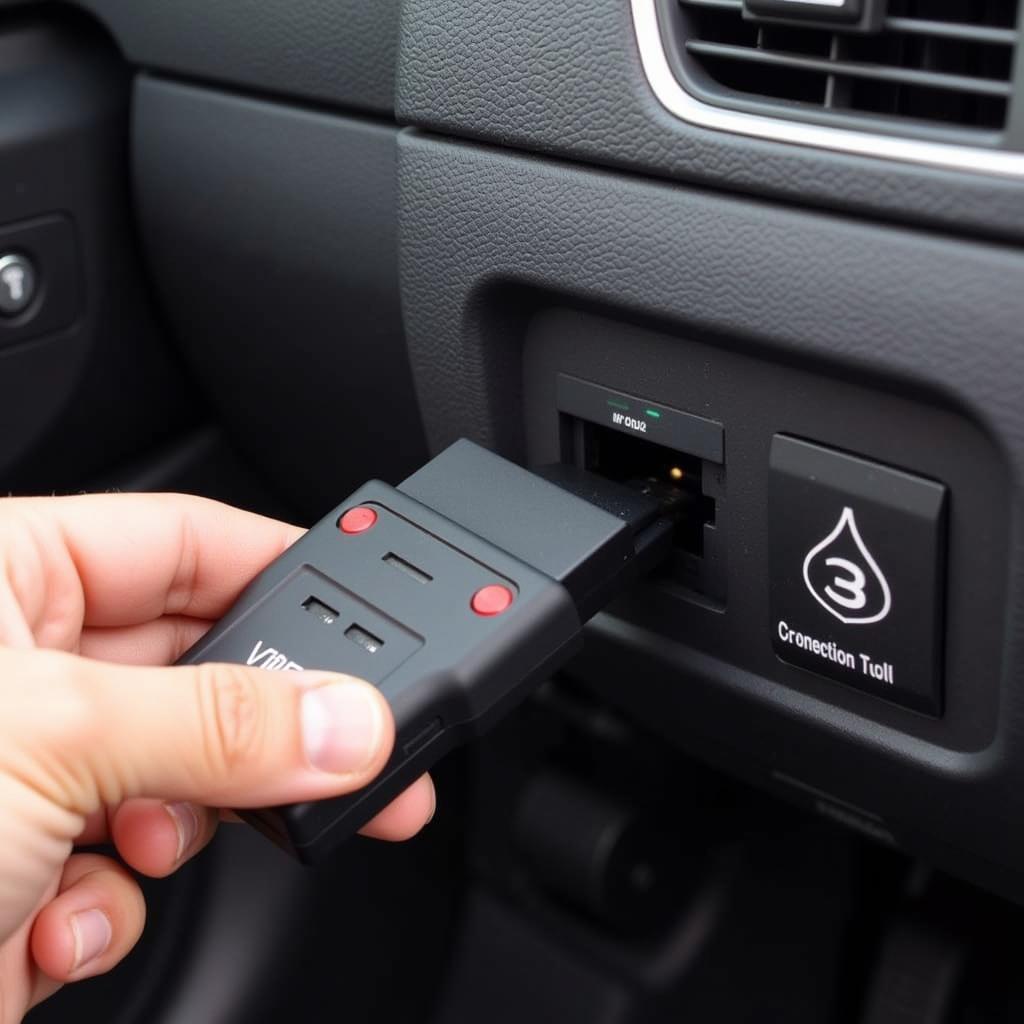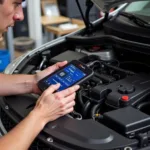Knowing where to plug in your car diagnostic tool for a VW Polo is crucial for effectively troubleshooting issues. Whether you’re a seasoned mechanic or a DIY enthusiast, understanding this process can save you time and money. Locating the OBD-II port on your Polo is the first step towards diagnosing and fixing those pesky check engine lights or performance problems.
Locating the OBD-II Port on Your VW Polo
The OBD-II (On-Board Diagnostics, second generation) port is the gateway to your Polo’s internal computer system. This standardized port allows you to connect a diagnostic tool to read and interpret fault codes, monitor live data, and perform various tests. Finding it on a VW Polo is generally straightforward, though the exact location might vary slightly depending on the model year.
Common OBD-II Port Locations in VW Polos
Most VW Polos have the OBD-II port located under the dashboard, on the driver’s side. It’s typically situated near the steering column or above the pedals. Look for a trapezoidal-shaped connector with 16 pins. It’s usually black or grey and may have a protective cap. Sometimes, it might be tucked away behind a panel, requiring you to gently pry it open.
- Under the steering wheel: Check beneath the steering column, looking towards the pedals. You may need to feel around to locate the port.
- Above the pedals: Look up from the footwell area, often above the accelerator, brake, or clutch pedal.
- Behind a panel: In some cases, the OBD-II port might be hidden behind a small removable panel. Gently inspect the area around the steering column and pedals for any removable sections.
Using Your Diagnostic Tool with a VW Polo
Once you’ve located the OBD-II port, connecting your diagnostic tool is simple. Just plug it in, ensuring a secure connection. Turn the ignition on, but don’t start the engine. Most diagnostic tools will then power up and allow you to access your Polo’s diagnostic data.
Troubleshooting Common Issues with Connecting a Diagnostic Tool to a VW Polo
Sometimes, you might encounter issues connecting your diagnostic tool. Here are some common problems and solutions:
- Loose Connection: Ensure the diagnostic tool is firmly plugged into the OBD-II port. A loose connection can prevent communication.
- Blown Fuse: Check the fuse box for any blown fuses related to the OBD-II port. Refer to your owner’s manual for the correct fuse location.
- Faulty Diagnostic Tool: Try using a different diagnostic tool to rule out a problem with your current one.
- Software Compatibility: Ensure your diagnostic tool’s software is compatible with your specific VW Polo model year.
 Connecting Diagnostic Tool to VW Polo OBD2 Port
Connecting Diagnostic Tool to VW Polo OBD2 Port
Advanced Diagnostic Techniques for VW Polos
Beyond basic code reading, advanced diagnostic tools offer features like live data monitoring, component activation, and adaptation. These capabilities allow you to delve deeper into your Polo’s systems and pinpoint the root cause of complex issues.
Understanding VW-Specific Fault Codes
VW Polos, like other Volkswagen vehicles, use specific fault codes. While generic OBD-II codes provide a general indication of the problem, VW-specific codes offer more precise information. Using a diagnostic tool that can read these codes is crucial for accurate diagnosis.
“Using a quality diagnostic tool designed for VW vehicles is paramount for effective troubleshooting. It’s like having a direct line to your car’s brain,” says Hans Zimmerman, Senior Automotive Technician at German Auto Solutions.
Conclusion
Knowing where to plug in your car diagnostic tool on a VW Polo empowers you to take control of your vehicle’s maintenance and repairs. By understanding the location of the OBD-II port and employing the right techniques, you can effectively diagnose and resolve issues, saving both time and money. Don’t hesitate to consult your owner’s manual or seek professional help if you encounter any difficulties.
FAQ
- What is the OBD-II port? The OBD-II port is a standardized connector that allows diagnostic tools to communicate with a vehicle’s computer system.
- Why can’t I find my VW Polo’s OBD-II port? It might be hidden behind a panel or located in a slightly different position than usual. Consult your owner’s manual for the exact location.
- What should I do if my diagnostic tool won’t connect? Check for a loose connection, blown fuses, or software compatibility issues.
- What are VW-specific fault codes? These are codes specific to Volkswagen vehicles that provide more detailed diagnostic information.
- Do I need a special diagnostic tool for my VW Polo? While generic tools work, a VW-specific tool often provides more comprehensive information.
Need assistance? Contact us via WhatsApp: +1(641)206-8880, Email: [email protected]. Our customer support team is available 24/7.


